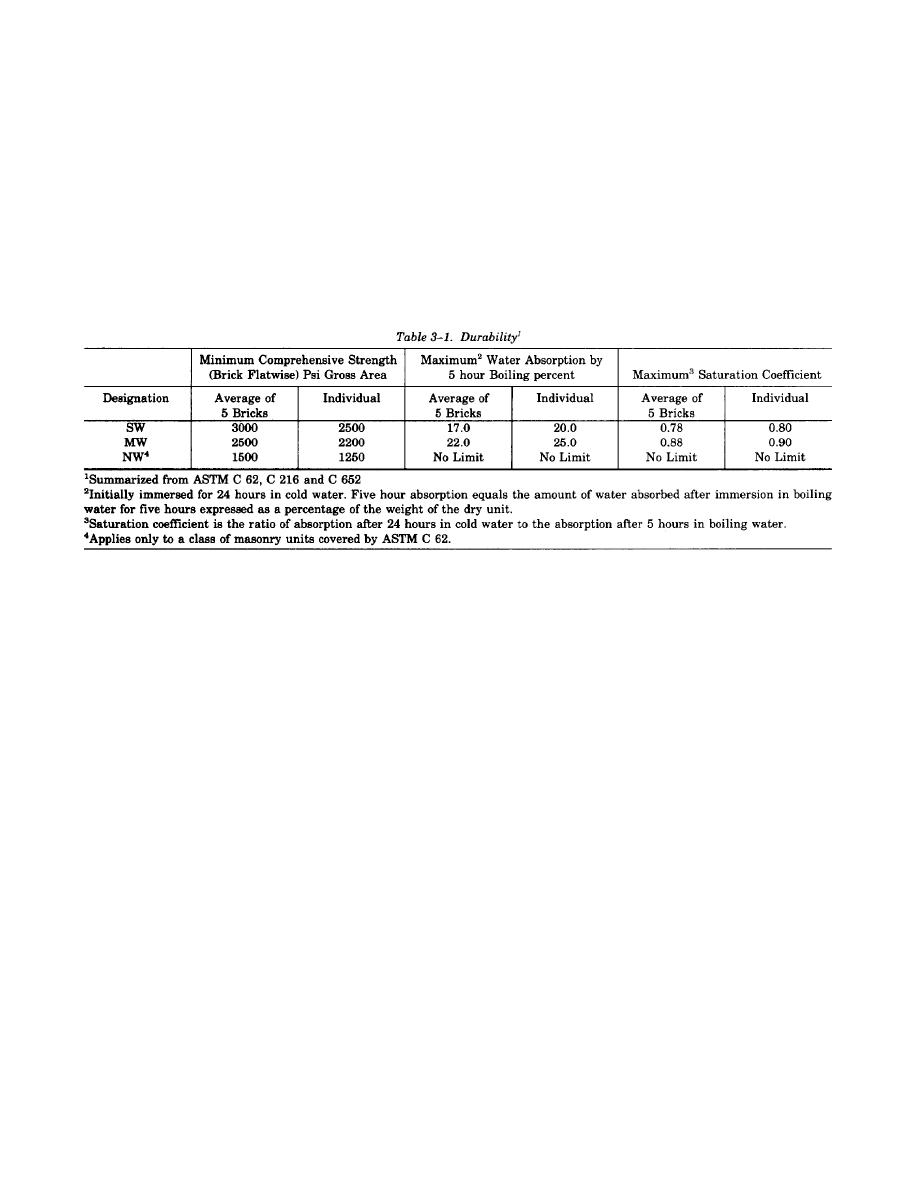
TM 5-809-3/NAVFAC DM-2.9/AFM 88-3, Chap. 3
(1) Durability. Durability primarily refers to
thus may influence structural performance. Various
types of surface texturing, which is formed by steel
the ability of a masonry unit to withstand environ-
wire cutting parallel to the direction of extrusion,
mental conditions, such as freeze-thaw action. Clay
may be created on the face surfaces of clay units.
masonry units have been classified in ASTM C 62,
Surface texture is a factor influencing bond
C 216, and C 652 according to their weather
strength between the clay units and the mortar or
resistant capacities into the following grades: Se-
grout.
vere Weathering, SW; Moderate Weathering, MW;
e. Material properties. Material properties of
and No Weathering, NW. Durability, or weather
clay masonry units which can affect their structural
resistance classification, is evaluated in terms of
performance include: durability, initial rate of
compressive strength and water absorption as pre-
absorption, compressive strength, flexural strength,
sented in table 3-1.
and expansion potential.
(2) initial rate of absorption. Clay masonry
the firing temperature and the ambient moisture
units have a tendency to draw water from mortar or
conditions. The initial expansion is irreversible.
grout with which they are in contact due to a
Additional, but small, amounts of contraction or
capillary mechanism caused by small pores in the
expansion due to temporary variations in masonry
units. This phenomenon is termed the initial rate of
moisture content may occur. Clay unit masonry is
absorption, IRA, or suction and has been linked to
also subject to expansion and contraction due to
structural characteristics of masonry such as the
temperature variations.
bond between mortar and the unit. The quality of
bond between mortar and masonry unit is a
3-3. Concrete masonry units. Concrete masonry
function of properties of each. However, for many
units are made from lightweight or normal weight
often used mortar mixes an IRA value in the 10-25
aggregates, or both, to obtain three classes of
grams per 30 square inches per minute range has
masonry units; normal weight, medium weight, and
been observed to be most desirable. Absorption test
lightweight. The structural requirements of ASTM
procedures can be found in ASTM C 67.
C 90 are the same for all classes. Normal weight
(3) Compressive strength. Compressive
units are generally used where lightweight
strength of clay masonry units is measured by
aggregate is not readily available and the cost of
loading specimens to failure in a direction
obtaining the lightweight aggregate does not offset
consistent with the direction of service loading in
the advantages of lightweight units. The advantages
accordance ASTM C 67. Compressive strength of
of lightweight units include ease of handling and
units provides a basis for assuming the compressive
hauling, increased productivity, reduced dead
strength of the masonry assemblage.
loads, improved resistance to thermal flow, im-
(4) Flexural strength. Flexural strength, or
proved absorption of transmitted sound, and higher
modulus of rupture, determined in accordance with
fire resistance. One disadvantage of lightweight
ASTM C 67, is basically a measure of the tensile
units is that they are more porous. This makes them
strength of a masonry unit. It is somewhat corre-
more difficult to paint or seal as required for
lated to unit compressive strength.
interior and exterior exposure.
(5) Expansion potential. Clay masonry units
a. Ingredients. Concrete masonry units primarily
immediately after manufacture are extremely dry
consist of portland cement or blended cement,
and expand due to absorption of moisture from the
aggregate and water. Hydrated lime and/or pozzo-
atmosphere. The magnitude of the initial expansion
lans as well as air entraining agents may be used.
depends on the characteristics of the unit materials,
Other ingredients that have been established as
3-2



 Previous Page
Previous Page
